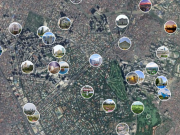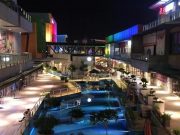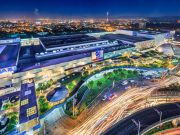
The Philippines has faced its fair share of challenges as the COVID-19 pandemic continues to reshape the global economic landscape. Renowned for imposing one of the world’s most enduring and stringent lockdowns, the country’s commercial sector has been significantly disrupted. This disruption, however, is only one part of the story. Amidst these trials, the sector has demonstrated remarkable resilience and adaptability, becoming a testament to the strength and tenacity of Filipino businesses.
This article provides an in-depth exploration of the Philippine commercial sector post-lockdown period. We’ll examine the effects of the pandemic, the response of differing industries, and the innovative strategies that have emerged as a result. Furthermore, we’ll look at the journey toward recovery, highlighting the sectors that have managed to not only survive but also thrive amidst adversity.
In doing so, we aim to provide a comprehensive overview of the current state of the commercial sector in the Philippines, offering valuable insights into its prospects. The road to recovery may be fraught with challenges, but as this analysis will show, the Philippine commercial sector is well on its way to rebounding stronger than ever.
I. Overview of the Philippine Economy
Before the onset of the COVID-19 pandemic, the Philippines boasted a thriving commercial sector that was instrumental in driving economic growth. The country’s vibrant economy, characterized by diverse industries and an active consumer market, was a testament to its robustness. However, like many economies worldwide, the Philippines was not immune to the devastating effects of the pandemic.
The year 2020 marked a challenging period for the nation as it plunged into a recession, with the economy contracting by a significant 9.6%. This was a stark contrast to the steady growth the country had experienced in previous years. The stringent lockdowns, while necessary for public health, led to the temporary closure of businesses, disruptions in supply chains, and a decline in consumer spending, all contributing factors to the economic downturn.
However, the Philippine economy has shown its resilience and capacity for recovery, bouncing back in the first quarter of 2021 with a growth rate of 5.6%. This rebound signals the country’s inherent strength and the tenacity of its commercial sector, even amidst a global crisis.
This recovery was driven by various factors, including the gradual easing of lockdown measures, the government’s stimulus packages aimed at reviving economic activity, and the resilience of specific sectors that managed to thrive despite the challenges. Furthermore, the rise of digital technologies and e-commerce platforms played a significant role in cushioning the economic blow, offering new avenues for business operations and consumer engagement.
As we delve deeper into the performance of the Philippine commercial sector post-lockdown, it’s essential to understand this backdrop. The story of the sector’s journey is one of resilience in the face of adversity, a testament to the strength of the Philippine economy.
II. Pre-Pandemic Economic Landscape and the Impact of COVID-19
The Philippines, before the pandemic, was recognized for its thriving commercial sector that significantly propelled its economic growth. The nation boasted one of the most dynamic economies in the East Asia and Pacific region, characterized by increasing urbanization and a growing consumer market. This robust economic landscape, however, came under severe strain with the advent of the COVID-19 pandemic in 2020.
The pandemic’s catastrophic impact led to a sharp contraction of the economy by 9.6%—a major setback after years of steady growth. Factors such as stringent lockdown measures, disruptions in global supply chains, temporary business closures, and a decline in consumer spending contributed to this downturn. This period marked one of the toughest economic phases for the country, casting a shadow over its previously vibrant commercial sector.
However, the Philippine economy demonstrated remarkable resilience in these trying times. In the first quarter of 2021, the country began to show signs of recovery as it posted a growth rate of 5.7%. Despite the lingering effects of the pandemic, this rebound provided a beacon of hope for the commercial sector.
Furthermore, the country’s economic landscape has continued to evolve during the pandemic. The rise of digital technologies and e-commerce platforms played a significant role in cushioning the economic blow, offering new avenues for business operations and consumer engagement. The outlook for sectors like travel and hospitality is also promising, with a full recovery to pre-pandemic levels expected by 2024.
As we move forward into 2023, the Philippine economy is experiencing one of the strongest recoveries in emerging markets. While there are still challenges to overcome, the economy is showing signs of returning to its pre-pandemic pace of expansion, paving the way for a resilient post-lockdown commercial sector
III. The Lockdown’s Impact on the Commercial Sector
The lockdown measures implemented to curb the spread of COVID-19 dealt a severe blow to the commercial sector, significantly affecting micro, small, and medium-sized enterprises (MSMEs). These businesses, which form the backbone of the Philippine economy, found themselves grappling with unprecedented challenges.
With strict mobility restrictions in place, many MSMEs were forced to either temporarily shut down or drastically reduce their operations. This led to substantial revenue losses and, in some cases, permanent closures. The impact was particularly felt in sectors that relied heavily on physical presence and customer interaction.
The retail sector, for instance, faced a sharp decline in foot traffic as domestic lockdowns kept consumers at home. Many brick-and-mortar stores, particularly those without an online presence, saw their sales plummet as a result. From clothing retailers to electronics shops, businesses across the retail spectrum felt the pinch.
Similarly, the tourism industry, once a thriving component of the commercial sector, faced significant setbacks due to international travel restrictions. With flights grounded and borders closed, tourist arrivals dropped dramatically. This had a cascading effect on related industries such as hospitality, food and beverage, and transportation, all of which rely heavily on tourism activity.
Even industries that were able to pivot to online operations faced hurdles. Supply chain disruptions, delivery bottlenecks, and logistical challenges added to the woes of businesses trying to navigate the new normal.
Despite these challenges, the commercial sector showed remarkable resilience. Businesses began exploring innovative strategies to adapt to the changing landscape, from embracing digital platforms to reimagining business models. The pandemic, while undoubtedly a severe setback, also spurred a wave of innovation and transformation in the Philippine commercial sector.
IV. Sectors that Thrived During the Pandemic
Despite the broad economic downturn, several sectors demonstrated remarkable resilience and adaptability, managing to thrive during the pandemic. The food manufacturing sector and grocery stores, for instance, witnessed a surge in demand as households stocked up on food and other essentials amidst the uncertainty.
Telecommunication services also experienced a boost, with more people working from home and relying heavily on digital platforms for communication, education, and entertainment. Interestingly, despite the health crisis, sales of “sin products” such as liquor and tobacco remained strong. These sectors capitalized on changing consumer behaviors and needs during the pandemic, demonstrating their adaptability.
V. Commercial Real Estate Prices during the Pandemic
The commercial real estate market initially took a hit due to the lockdown, with businesses closing down and a reduced need for physical office spaces contributing to a steep drop in prices. However, as restrictions began to ease and businesses adapted to the new normal, prices stabilized and showed signs of recovery.
The pandemic has not only accelerated trends such as flexible work arrangements but also witnessed a surge in the demand for flexible workspace solutions. This shift has exerted a significant influence on the commercial real estate market, compelling landlords and property owners to adapt their strategies accordingly. The need for versatile and adaptable workspace options has become even more crucial as businesses strive to navigate the evolving landscape and cater to the changing needs of their employees and clients.
As a result, land property owners and Brokerage companies like HousingInteractive are now exploring innovative approaches to meet the demands of the market while fostering productivity and collaboration in the ever-changing work environment. For instance, they provide a website portal and virtual home tour video for the properties. The pandemic has not only accelerated trends such as flexible work arrangements but has also led to a notable surge in the demand for flexible workspace solutions.
This significant shift has had a profound impact on the commercial real estate market, compelling landlords and property owners to reassess and adapt their strategies to effectively navigate these changing dynamics. As a result, the industry has seen a notable emphasis on creating versatile and dynamic workspace environments, catering to the evolving needs of businesses and individuals alike. The pandemic also accelerated trends like flexible work arrangements, leading to increased demand for flexible workspace solutions. This shift significantly influenced the commercial real estate market, necessitating landlords and property owners to adjust their strategies accordingly.
VI. The Digital Shift and E-commerce Boom
A notable trend that emerged during the lockdown was the massive digital shift. As physical stores closed and consumers stayed home, e-commerce platforms became essential for many Filipinos’ shopping needs. According to a report by Google, Temasek, and Bain & Company, the Philippines’ internet economy reached $7 billion in 2020, driven largely by the e-commerce sector.
This digital shift also extended to services such as online banking, telemedicine, and online education, as the pandemic accelerated the adoption of digital technologies across various sectors. This trend is expected to continue post-pandemic, signaling potential growth opportunities for businesses in the digital space.
VII. Recovery and Outlook for the Commercial Sector
With the gradual lifting of restrictions and the rollout of vaccination programs, the commercial sector is now transitioning into the recovery stage. Several factors are propelling this progress, including strong consumer demand, a resilient labor market, and consistent remittances from overseas Filipino workers.
In 2022, the retail sector was predicted to see a rise in vacancies due to new supply and mobility restrictions. However, the rollout of vaccine booster shots and the strengthening of e-commerce presence were recommended strategies for aiding recovery.
Photo courtesy of Asian Development Bank, Philippine Economy Seen Recovering in 2021, with Stronger Growth in 2022
Foreign direct investments (FDIs) continued to flow into the Philippines, with the property sector attracting a significant portion. This trend was expected to support post-Covid-19 growth in the industrial segment, especially in the Cavite–Laguna–Batangas (CALABA) corridor.
Despite the spread of Covid-19 variants and restrictions, domestic travel was expected to boost the leisure sector. The Department of Tourism anticipated “revenge travel” to increase hotel occupancies across selected destinations in the country. While challenges remain, the commercial sector’s inherent resilience and adaptability are seen as key drivers for recovery post-lockdown. For the most accurate and up-to-date information, I recommend regularly checking resources like the Colliers International website or other trusted real estate research platforms.
Moreover, the government has implemented several measures to support the commercial sector’s recovery, such as providing financial assistance to MSMEs and implementing policies to stimulate economic activity. These initiatives, coupled with the sector’s inherent resilience, bode well for its recovery prospects.
VIII. Conclusion
The Philippine commercial sector, like many others, has faced unprecedented challenges in the wake of the global pandemic and subsequent lockdown measures. However, amidst these trying times, the resilience and adaptability of the Filipino business community have shone through.
Post-lockdown, we have witnessed encouraging signs of recovery and rejuvenation within the commercial sector. From innovative business models to creative strategies, Filipino businesses have proven their ability to not just survive but thrive in an ever-changing landscape. Though the road to complete recovery may still be long and arduous, the commercial sector in the Philippines remains steadfast in its pursuit of growth and success.
What sets the Philippine commercial sector apart is its unwavering commitment to innovation and adaptability. From embracing digital transformation to exploring new markets, businesses in the Philippines have displayed a remarkable ability to think outside the box and find creative solutions to challenges.
As we navigate through these uncertain times, it is crucial to stay updated with the latest news and developments in the Philippine commercial sector. By staying informed, we can better equip ourselves with the knowledge and insights needed to make informed decisions and seize growth opportunities. Together, we can pave the way for a brighter and more prosperous future for the commercial sector in the Philippines.

























